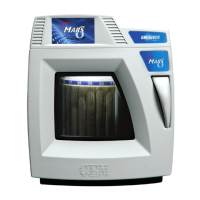3
General Safety
Microwave sample preparation imposes a unique set of safety considerations beyond the basics of good laboratory
practice. General guidelines for safe operation of laboratory microwave systems are presented below.
All vessel components must be dry and free of particulate matter. Drops of liquid or particles will absorb microwave
energy, causing localized heating which may char and damage vessel components, leading to possible vessel failure.
Never
heat liquids in a sealed vessel or container that is not equipped with a pressure relief device.
CEM does not recommend use of Parr Microwave Acid Digestion Bombs inside MARS 6 systems. Such usage constitutes
unreasonable operating conditions because Parr bombs cannot be connected to the pressure and temperature control
mechanisms of the MARS 6 and all software safeguards and safety relief devices are bypassed. CEM will not be
responsible for damage to the MARS 6 Microwave Digestion System or personal injuries resulting from use of Parr
microwave acid digestion bombs.
Never attempt to digest samples larger than 0.5 grams if the organic content and composition of the sample is unknown.
Unknown samples should be predigested for a minimum of 15 minutes in an unsealed vessel without any heating prior to
attempting a closed vessel digestion.
Minimum volume for the MARS 6 cavity is 10mL of acid or 50mL of water.
Microwave heating of alkaline or salt solutions in open or closed vessels will concentrate these solutions, causing
precipitation of salts and formation of crystal deposits on vessel walls. These crystal deposits will absorb microwave
energy, causing localized heating which may char and damage vessel components, leading to possible failure.
Never install a MARS 6 inside a laboratory fume hood. Acid and chemical fumes may attack the electrical components,
resulting in possible damage and malfunctioning of the cavity door safety interlocks. The proper method for installation of
the system and connection to a laboratory fume hood are described in this manual.
This instrument utilizes high voltages and microwave radiation in its operation. Instrument service and repair should be
undertaken only by technicians trained in repair and maintenance of high voltage and microwave power systems.
Daily, remove the ESP-1500 Plus cable connection from the bulkhead connection and thoroughly clean the connector with
a paper towel or soft cloth. Wipe and clean both the inside and outside surfaces of the connector. If necessary, dampen
the towel with isopropyl alcohol. To assist in cleaning.
If the MARS 6 is equipped with a sample stirrer, some danger exists if a pacemaker is positioned in close proximity to the
instrument cavity.
If the MARS 6 is equipped with IR sensors, each IR window or lens in the cavity floor should be cleaned weely or after any
spillage by wiping each lens with a damp soft cloth.

